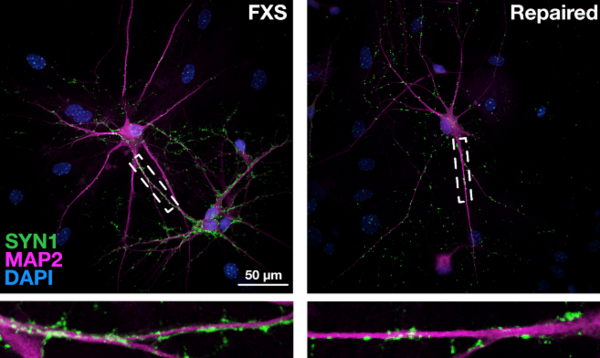
Although considered a rare disorder, fragile X syndrome is the most common genetic cause of intellectual disability in the world. Fragile X patients can have a range of mild to severe intellectual disability with the potential for other conditions such as autism, delayed motor development, hyperactivity, behavioral problems and seizures.
Although it’s well-known that fragile X is caused by the FMR1 gene, it’s less understood how the disorder physically affects brain development and function.
Christopher Patzke, the John M. and Mary Jo Boler Assistant Professor of Biological Sciences at the University of Notre Dame, is collaborating with fragile X patients and families to study the disorder.
“My lab is hoping to find an explanation of the disease symptoms in humans, looking at the disorder at the cellular and molecular level,” Patzke said.
By partnering with fragile X expert Dr. Elizabeth M. Berry-Kravis, professor of pediatrics at Rush University and a 1979 graduate of Notre Dame, the Patzke Lab has been able to collect patient tissue samples to create induced pluripotent stem cells. Because these stem cells mimic embryonic stem cells, the lab can then transform those cells into virtually any human cell the researchers want to study.
For this research, Patzke and his team are transforming pluripotent stem cells into brain cells that mimic neurons of someone with fragile X syndrome, creating a human model to study the genetic mutation’s effect on the brain.

“Most of the genes associated with intellectual disability encode for proteins that do something with synapses,” Patzke said. “So making a cell culture of these fragile X neurons allows us, in a way, to ‘zoom in’ to single cells and synapses, or the connections between neurons, and learn how these neurons communicate with one another.”
The researchers then compare a patient’s cell culture sample to a corrected-cell culture sample, made via gene editing, to analyze the differences between how the synapses function with and without the FMR1 gene mutation.
Although research into fragile X syndrome is not uncommon, many researchers use animal models to study the FMR1 gene. While some of the research has led to clinical trials, those results have yet to translate into effective benefits for humans. By using tissue from fragile X patients, the goal is to overcome this gap in discovery.
In addition to fragile X syndrome, the Patzke Lab is also studying other disorders that cause intellectual disability including Down syndrome and Kabuki syndrome, another rare disorder.
Patzke is affiliated with Notre Dame’s Boler-Parseghian Center for Rare and Neglected Diseases, among the first basic science rare disease research centers in the nation. Focused on both basic and translational research, the center works with families affected by rare diseases to combine studies of patient data and tissue with fundamental biological research in order to better understand disease, identify molecular targets and develop new diagnostics and treatments.
Contact: Brandi Wampler, associate director of media relations, 574-631-2632, brandiwampler@nd.edu
Originally published by at news.nd.edu on November 14, 2023.